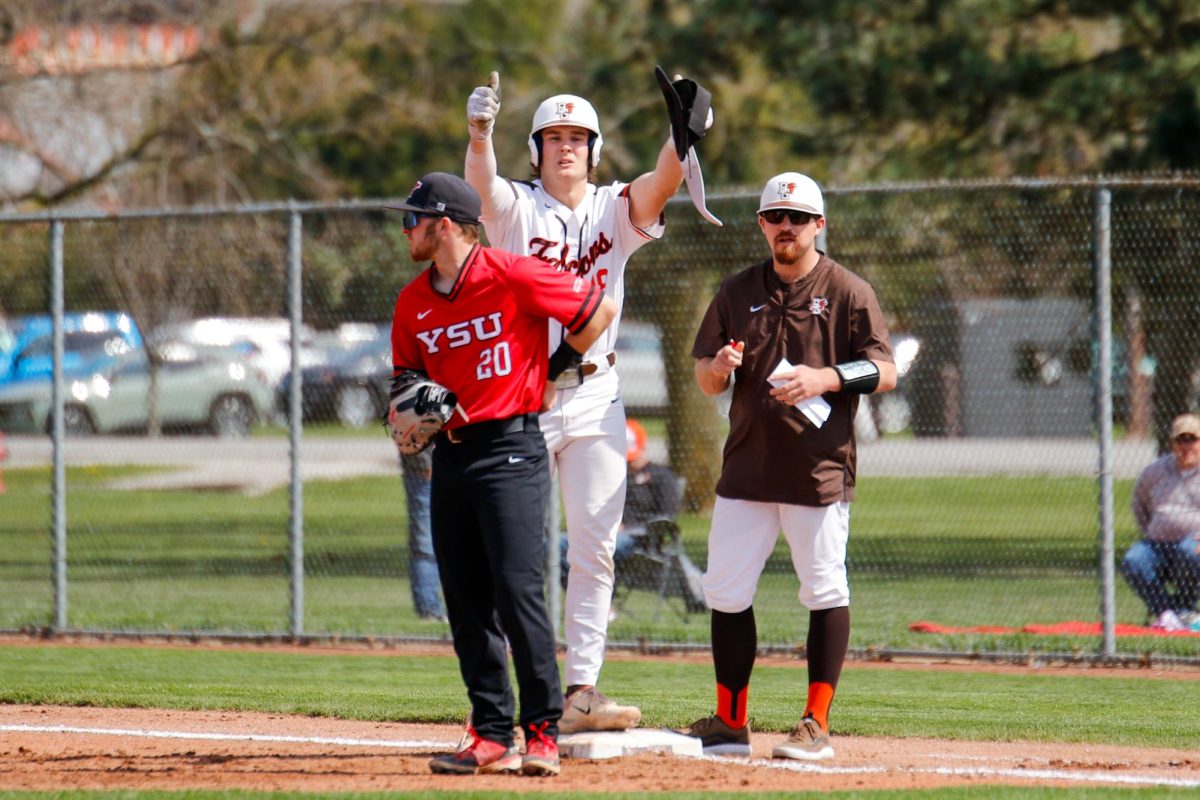From bring-your-own brown-bag lunches to mystery meat and Jell-O squares to the smorgasbord available today, University dining services have evolved during the past 100 years to keep up with students’ changing tastes.
In the early years, University students commuted to campus, according to Robert Overman’s book “The History of Bowling Green State University.” Food cost was very little for most students, as they did their own cooking and brought food from home.
As campus began to expand in the 1940s, wooden buildings were brought in, including a temporary mess hall called Commons.
Campus continued to expand through the 1950s and into the ’60s, according to Overman. Dave Maley, assistant director of facilities and planning for Dining Services, attended the University from 1965 to 1970 and has worked at the dining services for 37 years. Maley said in his college experience meal times were more structured than today; students were designated to eat in one dining area. Maley said the social scene in dining halls was very lively in the ’60s and ’70s. Food options were very limited until the 1970s, he said.
Nancy Joseph, director of operations for Dining Services, has worked at the University for more than 38 years. She said the food was very different when she first began her career here.
In the 1980s, restaurants circulated through dining halls across campus, and students began to work more in the dining halls in the 1990s.
Throughout the years dining halls and restaurants have come and gone, names have changed and buildings have been remodeled, but the University’s determination to please each generation’s food tastes has not swayed.
1914: During the first year of classes, most students commuted and brought their lunches from home. Students whose parents did not live in the area stayed in private homes; many did their own cooking and ate in local restaurants, which was quite inexpensive.
1916: All men lived off campus, and room and board for girls totaled $4.25 a week ($3 a week). Men actually lived cheaper than the women, because they brought their own food from home and did their own cooking. Food cost for men was low, as most of their parents were farmers.
1918-19: Board in Williams Hall was raised to $3.50 a week, mostly because the women launched complaints about the quality and quantity of the dorm food. “The girls said they would rather pay more and receive better meals. In fact they said the cost would be less, since they would not have to buy so many sandwiches and other snacks.”
Early 1930: Men continued to live off campus and cheaper than most of the women because they brought food from home. Milk was usually the only item they bought on campus, but even in winter they brought food from home.
1942-43: A student union, dubbed Falcon’s Nest, opened, adding a $1 fee per semester. There were now men’s dorms; board was still $3.50 a week for women, $4 a week for men.
Late 1940s: Buildings were moved onto campus.
1947: A wooden mess hall was transported from Camp Perry to serve as a temporary dining hall; President Prout re-christened the hall Commons.
1950-51: Campus was rapidly expanding, and temporary housing for students was overcrowded. Board went from $81 to $126 that year, and went up again the following year to $144.
Early 1960s: Room and board increased again, due to an increase in food and services cost and the construction of new dormitories.
1964: The Harshman Quadrangle was completed, with a central kitchen, dining rooms and snack bar. It was meant to replace the old wooden Commons.
Late 1960s: Meals were served during a two-hour window, three times a day. If students missed a meal they had to pay cash at one of the two snack bars located in Commons and in
Harshman. Maley said prices were reasonable; cheeseburgers were 35 cents.
Students could not go for seconds of an entree, but could have two salads or two sides.
“A typical salad was either canned fruit or … a Jell-O square on a lettuce leaf, which was always a joke,” Maley said. “That could’ve been a logo for dining services: ‘Jell-O square on lettuce.'”
“I had no complaints believe it or not, and back then it wasn’t in the culture … I never went hungry,” Maley said.
“They were more homestyle, you know, there was maybe the mystery meatloaf if you will, Salisbury steak, baked spaghetti, very basic,” he said.
1971: Dining services switched to an “a la carte” system; students used coupon books to purchase a wider variety or individualized items, like sandwiches.
Late 1970s: Towers Inn Restaurant opened in McDonald and was active until the late 1990s. Also, the Strawberry Patch, a pancake house in Harshman, opened and became very popular; it later changed to Berries in the ’80s.
1980s: Commons dining center was ‘The Truckstop.’ It was established because primarily men ate there, and they wanted hearty, larger-portion meals.
“The big ‘CB ten-four good buddy’ era [was] going on,” Joseph said. “That was a big hit.”
Also, today’s Outtakes area was an empty dining space students could reserve for “beer blasts,” Joseph said.
“They would rent that space out and that was a space on campus that fraternities and sororities could have alcohol,” Joseph said. “It was always a mess to clean up after … it reeked of beer, but yes, back in the ’80’s that was a party location.”
1980s: McDonald dining hall housed Garden Terrace Deli and Soda Shoppe, where students could get an ice cream sundae for less than $2 and a create-your-own sandwich or “Bagelwich” for less than $2.50.
Late ’80s early ’90s: Dining Services hosted elaborate themed dinners celebrating events such as the opening of the Rock and Roll Hall of Fame and the Olympics to break monotony for students.
“They pulled out all the stops for these dinners,” Joseph said. “There were props, special menus … it was done as a monotony breaker and something for the students to really look forward to.”
Also in the 80s: Recipe development was conducted to enhance students’ casual dining experience, including student tastings to gain student perspectives on food options.
Early 90s: Founders was gutted, remodeled and reopened with the first resident dining food court.
1991-92: Meal plan costs were a minimum of $575 and the Super Plus plan cost $1,055 per year.
Mid 90s: Due to a budget crisis, students began to make an appearance on the dining employment scene, filling positions of fleeting dining staff.
1995: Kreischer received a “modified remodel,” with different dining venues, Joseph said.
Early 2000s: University started branding with eateries like BGSUb and Mama Margie’s Pizza.
Mid 2000s: Towers Inn in McDonald reopened as Campus Corners.
2002: Bowen-Thompson Student Union officially opened its doors.
July 2009: Chartwells came in and “resources bloomed,” Maley said. Chartwells enhanced the Univeristy’s national branding ability, bringing in entities like Dunkin’ Donuts and Jamba Juice.
Source: Dave Maley, assistant director of facilities and planning for Dining Services
Nancy Joseph, director of operations for Dining Services.
“The History of Bowling Green State University,” by James Robert Overman.

















